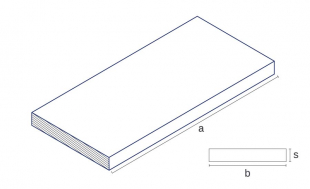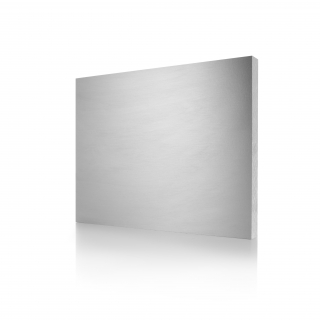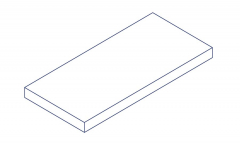-
Chemische Zusammensetzung
|
Be (von)
|
0
|
|
Be (bis)
|
0
|
|
Co (von)
|
0
|
|
Co (bis)
|
0
|
|
Cr (von)
|
0
|
|
Cr (bis)
|
0,1
|
|
Cu (von)
|
3,8
|
|
Cu (bis)
|
4,9
|
|
Fe (von)
|
0
|
|
Fe (bis)
|
0,3
|
|
Mg (von)
|
1,2
|
|
Mg (bis)
|
1,8
|
|
Mn (von)
|
0,3
|
|
Mn (bis)
|
0,9
|
|
Andere
|
max. 0,05
|
|
Rest
|
Al
|
|
Si (von)
|
0
|
|
Si (bis)
|
0,2
|
|
Ti (von)
|
0
|
|
Ti (bis)
|
0,15
|
|
Gesamt
|
max. 0,15
|
|
Zn (von)
|
0
|
|
Zn (bis)
|
0,25
|
|
Zr Fußnoten Referenz
|
c)
|
-
Lebensmittelindustrie
|
geeignet nach DIN EN 602
|
Nein
|
-
Luftfahrt
-
physikalische Eigenschaften
|
Wärmeausdehnungskoeffizient von 20 bis 100°C
|
22,9 K⁻¹10⁻⁶
|
|
Wärmeausdehnungskoeffizient von 20 bis 200°C
|
23,8 K⁻¹10⁻⁶
|
|
Wärmeausdehnungskoeffizient von 20 bis 300°C
|
24,7 K⁻¹10⁻⁶
|
|
Wärmeausdehnungskoeffizient von -50 bis 20°C
|
21,1 K⁻¹10⁻⁶
|
|
Dichte
|
2,78 g/cm³
|
|
Elastizitätsmodul
|
73 GPa
|
|
Schubmodul
|
27 GPa
|
|
Spezifische Wärme
|
882 J/(kg·K)
|
|
Wärmeleitfähigkeit max.
|
190 W/m*K
|
|
Wärmeleitfähigkeit min.
|
150 W/m*K
|
-
Werkstoff
|
Werkstoff chemisch EN 573-3
|
ENAW-2124
|
-
Wärmebehandlung - Weichglühen
|
Glühtemperatur min.
|
413 °C
|
-
Chemische Zusammensetzung
|
Be (von)
|
0
|
|
Be (bis)
|
0
|
|
Co (von)
|
0
|
|
Co (bis)
|
0
|
|
Cr (von)
|
0
|
|
Cr (bis)
|
0,1
|
|
Cu (von)
|
3,8
|
|
Cu (bis)
|
4,9
|
|
Fe (von)
|
0
|
|
Fe (bis)
|
0,3
|
|
Mg (von)
|
1,2
|
|
Mg (bis)
|
1,8
|
|
Mn (von)
|
0,3
|
|
Mn (bis)
|
0,9
|
|
Andere
|
max. 0,05
|
|
Rest
|
Al
|
|
Si (von)
|
0
|
|
Si (bis)
|
0,2
|
|
Ti (von)
|
0
|
|
Ti (bis)
|
0,15
|
|
Gesamt
|
max. 0,15
|
|
Zn (von)
|
0
|
|
Zn (bis)
|
0,25
|
|
Zr Fußnoten Referenz
|
c)
|
-
Lebensmittelindustrie
|
geeignet nach DIN EN 602
|
Nein
|
-
Luftfahrt
-
physikalische Eigenschaften
|
Wärmeausdehnungskoeffizient von 20 bis 100°C
|
22,9 K⁻¹10⁻⁶
|
|
Wärmeausdehnungskoeffizient von 20 bis 200°C
|
23,8 K⁻¹10⁻⁶
|
|
Wärmeausdehnungskoeffizient von 20 bis 300°C
|
24,7 K⁻¹10⁻⁶
|
|
Wärmeausdehnungskoeffizient von -50 bis 20°C
|
21,1 K⁻¹10⁻⁶
|
|
Dichte
|
2,78 g/cm³
|
|
Elastizitätsmodul
|
73 GPa
|
|
Schubmodul
|
27 GPa
|
|
Spezifische Wärme
|
882 J/(kg·K)
|
|
Wärmeleitfähigkeit max.
|
190 W/m*K
|
|
Wärmeleitfähigkeit min.
|
150 W/m*K
|
-
Werkstoff
|
Werkstoff chemisch EN 573-3
|
ENAW-2124
|
-
Wärmebehandlung - Weichglühen
|
Glühtemperatur min.
|
413 °C
|
-
Chemische Zusammensetzung
|
Be (von)
|
0
|
|
Be (bis)
|
0
|
|
Co (von)
|
0
|
|
Co (bis)
|
0
|
|
Cr (von)
|
0
|
|
Cr (bis)
|
0,1
|
|
Cu (von)
|
3,8
|
|
Cu (bis)
|
4,9
|
|
Fe (von)
|
0
|
|
Fe (bis)
|
0,3
|
|
Mg (von)
|
1,2
|
|
Mg (bis)
|
1,8
|
|
Mn (von)
|
0,3
|
|
Mn (bis)
|
0,9
|
|
Andere
|
max. 0,05
|
|
Rest
|
Al
|
|
Si (von)
|
0
|
|
Si (bis)
|
0,2
|
|
Ti (von)
|
0
|
|
Ti (bis)
|
0,15
|
|
Gesamt
|
max. 0,15
|
|
Zn (von)
|
0
|
|
Zn (bis)
|
0,25
|
|
Zr Fußnoten Referenz
|
c)
|
-
Lebensmittelindustrie
|
geeignet nach DIN EN 602
|
Nein
|
-
Luftfahrt
-
physikalische Eigenschaften
|
Wärmeausdehnungskoeffizient von 20 bis 100°C
|
22,9 K⁻¹10⁻⁶
|
|
Wärmeausdehnungskoeffizient von 20 bis 200°C
|
23,8 K⁻¹10⁻⁶
|
|
Wärmeausdehnungskoeffizient von 20 bis 300°C
|
24,7 K⁻¹10⁻⁶
|
|
Wärmeausdehnungskoeffizient von -50 bis 20°C
|
21,1 K⁻¹10⁻⁶
|
|
Dichte
|
2,78 g/cm³
|
|
Elastizitätsmodul
|
73 GPa
|
|
Schubmodul
|
27 GPa
|
|
Spezifische Wärme
|
882 J/(kg·K)
|
|
Wärmeleitfähigkeit max.
|
190 W/m*K
|
|
Wärmeleitfähigkeit min.
|
150 W/m*K
|
-
Werkstoff
|
Werkstoff chemisch EN 573-3
|
ENAW-2124
|
-
Wärmebehandlung - Weichglühen
|
Glühtemperatur min.
|
413 °C
|
-
Chemische Zusammensetzung
|
Be (von)
|
0
|
|
Be (bis)
|
0
|
|
Co (von)
|
0
|
|
Co (bis)
|
0
|
|
Cr (von)
|
0
|
|
Cr (bis)
|
0,1
|
|
Cu (von)
|
3,8
|
|
Cu (bis)
|
4,9
|
|
Fe (von)
|
0
|
|
Fe (bis)
|
0,3
|
|
Mg (von)
|
1,2
|
|
Mg (bis)
|
1,8
|
|
Mn (von)
|
0,3
|
|
Mn (bis)
|
0,9
|
|
Andere
|
max. 0,05
|
|
Rest
|
Al
|
|
Si (von)
|
0
|
|
Si (bis)
|
0,2
|
|
Ti (von)
|
0
|
|
Ti (bis)
|
0,15
|
|
Gesamt
|
max. 0,15
|
|
Zn (von)
|
0
|
|
Zn (bis)
|
0,25
|
|
Zr Fußnoten Referenz
|
c)
|
-
Lebensmittelindustrie
|
geeignet nach DIN EN 602
|
Nein
|
-
Luftfahrt
-
physikalische Eigenschaften
|
Wärmeausdehnungskoeffizient von 20 bis 100°C
|
22,9 K⁻¹10⁻⁶
|
|
Wärmeausdehnungskoeffizient von 20 bis 200°C
|
23,8 K⁻¹10⁻⁶
|
|
Wärmeausdehnungskoeffizient von 20 bis 300°C
|
24,7 K⁻¹10⁻⁶
|
|
Wärmeausdehnungskoeffizient von -50 bis 20°C
|
21,1 K⁻¹10⁻⁶
|
|
Dichte
|
2,78 g/cm³
|
|
Elastizitätsmodul
|
73 GPa
|
|
Schubmodul
|
27 GPa
|
|
Spezifische Wärme
|
882 J/(kg·K)
|
|
Wärmeleitfähigkeit max.
|
190 W/m*K
|
|
Wärmeleitfähigkeit min.
|
150 W/m*K
|
-
Werkstoff
|
Werkstoff chemisch EN 573-3
|
ENAW-2124
|
-
Wärmebehandlung - Weichglühen
|
Glühtemperatur min.
|
413 °C
|
-
Chemische Zusammensetzung
|
Be (von)
|
0
|
|
Be (bis)
|
0
|
|
Co (von)
|
0
|
|
Co (bis)
|
0
|
|
Cr (von)
|
0
|
|
Cr (bis)
|
0,1
|
|
Cu (von)
|
3,8
|
|
Cu (bis)
|
4,9
|
|
Fe (von)
|
0
|
|
Fe (bis)
|
0,3
|
|
Mg (von)
|
1,2
|
|
Mg (bis)
|
1,8
|
|
Mn (von)
|
0,3
|
|
Mn (bis)
|
0,9
|
|
Andere
|
max. 0,05
|
|
Rest
|
Al
|
|
Si (von)
|
0
|
|
Si (bis)
|
0,2
|
|
Ti (von)
|
0
|
|
Ti (bis)
|
0,15
|
|
Gesamt
|
max. 0,15
|
|
Zn (von)
|
0
|
|
Zn (bis)
|
0,25
|
|
Zr Fußnoten Referenz
|
c)
|
-
Lebensmittelindustrie
|
geeignet nach DIN EN 602
|
Nein
|
-
Luftfahrt
-
physikalische Eigenschaften
|
Wärmeausdehnungskoeffizient von 20 bis 100°C
|
22,9 K⁻¹10⁻⁶
|
|
Wärmeausdehnungskoeffizient von 20 bis 200°C
|
23,8 K⁻¹10⁻⁶
|
|
Wärmeausdehnungskoeffizient von 20 bis 300°C
|
24,7 K⁻¹10⁻⁶
|
|
Wärmeausdehnungskoeffizient von -50 bis 20°C
|
21,1 K⁻¹10⁻⁶
|
|
Dichte
|
2,78 g/cm³
|
|
Elastizitätsmodul
|
73 GPa
|
|
Schubmodul
|
27 GPa
|
|
Spezifische Wärme
|
882 J/(kg·K)
|
|
Wärmeleitfähigkeit max.
|
190 W/m*K
|
|
Wärmeleitfähigkeit min.
|
150 W/m*K
|
-
Werkstoff
|
Werkstoff chemisch EN 573-3
|
ENAW-2124
|
-
Wärmebehandlung - Weichglühen
|
Glühtemperatur min.
|
413 °C
|
-
Chemische Zusammensetzung
|
Be (von)
|
0
|
|
Be (bis)
|
0
|
|
Co (von)
|
0
|
|
Co (bis)
|
0
|
|
Cr (von)
|
0
|
|
Cr (bis)
|
0,1
|
|
Cu (von)
|
3,8
|
|
Cu (bis)
|
4,9
|
|
Fe (von)
|
0
|
|
Fe (bis)
|
0,3
|
|
Mg (von)
|
1,2
|
|
Mg (bis)
|
1,8
|
|
Mn (von)
|
0,3
|
|
Mn (bis)
|
0,9
|
|
Andere
|
max. 0,05
|
|
Rest
|
Al
|
|
Si (von)
|
0
|
|
Si (bis)
|
0,2
|
|
Ti (von)
|
0
|
|
Ti (bis)
|
0,15
|
|
Gesamt
|
max. 0,15
|
|
Zn (von)
|
0
|
|
Zn (bis)
|
0,25
|
|
Zr Fußnoten Referenz
|
c)
|
-
Lebensmittelindustrie
|
geeignet nach DIN EN 602
|
Nein
|
-
Luftfahrt
-
physikalische Eigenschaften
|
Wärmeausdehnungskoeffizient von 20 bis 100°C
|
22,9 K⁻¹10⁻⁶
|
|
Wärmeausdehnungskoeffizient von 20 bis 200°C
|
23,8 K⁻¹10⁻⁶
|
|
Wärmeausdehnungskoeffizient von 20 bis 300°C
|
24,7 K⁻¹10⁻⁶
|
|
Wärmeausdehnungskoeffizient von -50 bis 20°C
|
21,1 K⁻¹10⁻⁶
|
|
Dichte
|
2,78 g/cm³
|
|
Elastizitätsmodul
|
73 GPa
|
|
Schubmodul
|
27 GPa
|
|
Spezifische Wärme
|
882 J/(kg·K)
|
|
Wärmeleitfähigkeit max.
|
190 W/m*K
|
|
Wärmeleitfähigkeit min.
|
150 W/m*K
|
-
Werkstoff
|
Werkstoff chemisch EN 573-3
|
ENAW-2124
|
-
Wärmebehandlung - Weichglühen
|
Glühtemperatur min.
|
413 °C
|
-
Chemische Zusammensetzung
|
Be (von)
|
0
|
|
Be (bis)
|
0
|
|
Co (von)
|
0
|
|
Co (bis)
|
0
|
|
Cr (von)
|
0
|
|
Cr (bis)
|
0,1
|
|
Cu (von)
|
3,8
|
|
Cu (bis)
|
4,9
|
|
Fe (von)
|
0
|
|
Fe (bis)
|
0,3
|
|
Mg (von)
|
1,2
|
|
Mg (bis)
|
1,8
|
|
Mn (von)
|
0,3
|
|
Mn (bis)
|
0,9
|
|
Andere
|
max. 0,05
|
|
Rest
|
Al
|
|
Si (von)
|
0
|
|
Si (bis)
|
0,2
|
|
Ti (von)
|
0
|
|
Ti (bis)
|
0,15
|
|
Gesamt
|
max. 0,15
|
|
Zn (von)
|
0
|
|
Zn (bis)
|
0,25
|
|
Zr Fußnoten Referenz
|
c)
|
-
Lebensmittelindustrie
|
geeignet nach DIN EN 602
|
Nein
|
-
Luftfahrt
-
physikalische Eigenschaften
|
Wärmeausdehnungskoeffizient von 20 bis 100°C
|
22,9 K⁻¹10⁻⁶
|
|
Wärmeausdehnungskoeffizient von 20 bis 200°C
|
23,8 K⁻¹10⁻⁶
|
|
Wärmeausdehnungskoeffizient von 20 bis 300°C
|
24,7 K⁻¹10⁻⁶
|
|
Wärmeausdehnungskoeffizient von -50 bis 20°C
|
21,1 K⁻¹10⁻⁶
|
|
Dichte
|
2,78 g/cm³
|
|
Elastizitätsmodul
|
73 GPa
|
|
Schubmodul
|
27 GPa
|
|
Spezifische Wärme
|
882 J/(kg·K)
|
|
Wärmeleitfähigkeit max.
|
190 W/m*K
|
|
Wärmeleitfähigkeit min.
|
150 W/m*K
|
-
Werkstoff
|
Werkstoff chemisch EN 573-3
|
ENAW-2124
|
-
Wärmebehandlung - Weichglühen
|
Glühtemperatur min.
|
413 °C
|
-
Chemische Zusammensetzung
|
Be (von)
|
0
|
|
Be (bis)
|
0
|
|
Co (von)
|
0
|
|
Co (bis)
|
0
|
|
Cr (von)
|
0
|
|
Cr (bis)
|
0,1
|
|
Cu (von)
|
3,8
|
|
Cu (bis)
|
4,9
|
|
Fe (von)
|
0
|
|
Fe (bis)
|
0,3
|
|
Mg (von)
|
1,2
|
|
Mg (bis)
|
1,8
|
|
Mn (von)
|
0,3
|
|
Mn (bis)
|
0,9
|
|
Andere
|
max. 0,05
|
|
Rest
|
Al
|
|
Si (von)
|
0
|
|
Si (bis)
|
0,2
|
|
Ti (von)
|
0
|
|
Ti (bis)
|
0,15
|
|
Gesamt
|
max. 0,15
|
|
Zn (von)
|
0
|
|
Zn (bis)
|
0,25
|
|
Zr Fußnoten Referenz
|
c)
|
-
Lebensmittelindustrie
|
geeignet nach DIN EN 602
|
Nein
|
-
Luftfahrt
-
physikalische Eigenschaften
|
Wärmeausdehnungskoeffizient von 20 bis 100°C
|
22,9 K⁻¹10⁻⁶
|
|
Wärmeausdehnungskoeffizient von 20 bis 200°C
|
23,8 K⁻¹10⁻⁶
|
|
Wärmeausdehnungskoeffizient von 20 bis 300°C
|
24,7 K⁻¹10⁻⁶
|
|
Wärmeausdehnungskoeffizient von -50 bis 20°C
|
21,1 K⁻¹10⁻⁶
|
|
Dichte
|
2,78 g/cm³
|
|
Elastizitätsmodul
|
73 GPa
|
|
Schubmodul
|
27 GPa
|
|
Spezifische Wärme
|
882 J/(kg·K)
|
|
Wärmeleitfähigkeit max.
|
190 W/m*K
|
|
Wärmeleitfähigkeit min.
|
150 W/m*K
|
-
Werkstoff
|
Werkstoff chemisch EN 573-3
|
ENAW-2124
|
-
Wärmebehandlung - Weichglühen
|
Glühtemperatur min.
|
413 °C
|
-
Chemische Zusammensetzung
|
Be (von)
|
0
|
|
Be (bis)
|
0
|
|
Co (von)
|
0
|
|
Co (bis)
|
0
|
|
Cr (von)
|
0
|
|
Cr (bis)
|
0,1
|
|
Cu (von)
|
3,8
|
|
Cu (bis)
|
4,9
|
|
Fe (von)
|
0
|
|
Fe (bis)
|
0,3
|
|
Mg (von)
|
1,2
|
|
Mg (bis)
|
1,8
|
|
Mn (von)
|
0,3
|
|
Mn (bis)
|
0,9
|
|
Andere
|
max. 0,05
|
|
Rest
|
Al
|
|
Si (von)
|
0
|
|
Si (bis)
|
0,2
|
|
Ti (von)
|
0
|
|
Ti (bis)
|
0,15
|
|
Gesamt
|
max. 0,15
|
|
Zn (von)
|
0
|
|
Zn (bis)
|
0,25
|
|
Zr Fußnoten Referenz
|
c)
|
-
Lebensmittelindustrie
|
geeignet nach DIN EN 602
|
Nein
|
-
Luftfahrt
-
physikalische Eigenschaften
|
Wärmeausdehnungskoeffizient von 20 bis 100°C
|
22,9 K⁻¹10⁻⁶
|
|
Wärmeausdehnungskoeffizient von 20 bis 200°C
|
23,8 K⁻¹10⁻⁶
|
|
Wärmeausdehnungskoeffizient von 20 bis 300°C
|
24,7 K⁻¹10⁻⁶
|
|
Wärmeausdehnungskoeffizient von -50 bis 20°C
|
21,1 K⁻¹10⁻⁶
|
|
Dichte
|
2,78 g/cm³
|
|
Elastizitätsmodul
|
73 GPa
|
|
Schubmodul
|
27 GPa
|
|
Spezifische Wärme
|
882 J/(kg·K)
|
|
Wärmeleitfähigkeit max.
|
190 W/m*K
|
|
Wärmeleitfähigkeit min.
|
150 W/m*K
|
-
Werkstoff
|
Werkstoff chemisch EN 573-3
|
ENAW-2124
|
-
Wärmebehandlung - Weichglühen
|
Glühtemperatur min.
|
413 °C
|
1 sehr gut
2 gut
3 mäßig
4 schlecht
5 ungeeignet
0 keine Angabe






